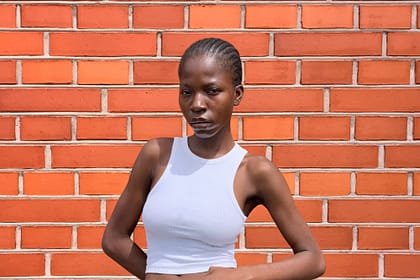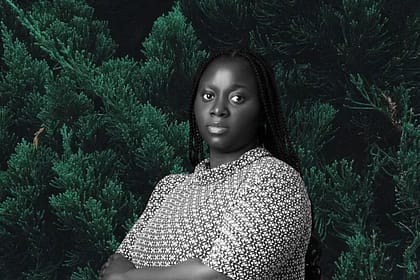In this edition of The Lane, novelist Amaka Azie opens a window into the tender and tumultuous world of The Girl in the Picture, a young adult story about belonging, self-discovery, and growing up between continents. Speaking with James Melbin, Azie traces the spark that began with a fleeting social media post and grew into a deeply human exploration of migration, culture shock, and resilience. Drawing from her own experiences of living between Nigeria and the UK, she crafts a story that mirrors the quiet courage of many young Africans abroad: those learning to balance home and heart, heritage and identity, all while finding their own voice in a world that often misunderstands them.
What first inspired The Girl in the Picture? Was there a particular moment or story that sparked Fechi’s journey for you?
I was inspired by an Instagram post about a couple who had recently relocated abroad and were arguing because the wife felt her husband wasn’t helping around the house. Back in Nigeria, she’d been a full-time housewife, but after relocating, she had to work, and juggling everything caused tension between them. The argument almost turned physical, and they had a teenage daughter watching it all unfold. I began to wonder what that experience would look like from her perspective. That’s what sparked Fechi’s journey for me.
The book beautifully captures the shock of moving between cultures. How much of that came from your own experiences or observations?
Oh, I experienced several culture shocks when I moved to the UK! I still remember the first time I saw a public display of affection at a train station. It was between two women, but that wasn’t what surprised me. What surprised me was how people just walked by without a glance. In Nigeria, there would have been so many nosy onlookers telling them to “stop that and go somewhere private!” Haha.
That said, much of Fechi’s experience also came from stories I’ve heard over the years.
Fechi is such a vivid character: curious, conflicted, and brave. How did you build her voice, and what parts of her felt closest to you as you wrote?
Thank you! I wanted to capture how complicated being a teenager is, a time when you feel adult emotions but are still very much a child. Fechi falls in love but still has to obey her parents’ rules and navigate her feelings under their supervision.
I felt closest to her during her argument with her parents about inviting Darren over for dinner. It made me reflect. As a parent, would I be that flexible? I realised I would. I’d rather my daughters be open about their relationships than sneak behind my back. If I had sons, I’d feel the same. Secrets are worse than difficult conversations.
The story deals with themes of belonging, identity, and growing up between worlds. How did you want to portray the emotional reality of that transition for young people today?
I wanted to be as honest as possible and show how confusing and lonely it can be to form a new identity in an unfamiliar place. Fechi struggles to fit in, and I wanted readers to feel that struggle. Change is hard for adults, but it’s even harder for teenagers who are already dealing with so many emotional and hormonal shifts.
Max and Darren each represent very different kinds of connections for Fechi. What do these relationships reveal about the choices young people face while finding themselves?
We often gravitate toward people we think will understand us. Max was Fechi’s automatic crush because he was half-Nigerian. She assumed he’d relate to her experiences. But reality surprised her. Darren, on the other hand, treated her differently than she expected, showing that we shouldn’t judge people by appearances, but by how they treat us.
There’s a strong undercurrent of resilience throughout the novel. What does resilience mean to you in the context of youth, migration, and identity?
To me, resilience means waking up each day ready to face the world without letting yesterday hold you back. Relocating is hard—you have to learn a new way of life, new food, and new friends. But focusing on one day at a time, doing your best in small ways, is what moves you forward.
Identity, to me, is whatever you say it is. You have to believe in who you are before you can expect anyone else to.
The book touches on culture shock, loneliness, and self-definition. Were these themes you set out to explore from the beginning, or did they emerge as the story unfolded?
I’m definitely a plotter! Before I started writing, I already knew I wanted to explore themes of identity and self-discovery, especially what it means to find yourself in a new environment.
One of the striking things about The Girl in the Picture is how it balances heartbreak with warmth and hope. How do you achieve that tonal balance as a writer?
Writing is a journey. I do a lot of research, talk to people who’ve had similar experiences. While writing this book, I interviewed three teenagers, especially my daughter, who was such a helpful sounding board for this story.
I always build my characters and plot in advance. By the time I typed chapter one, I already knew who Fechi was. My job was simply to bring her to life through words. I’m glad you think the balance came through!
You’ve written romance and emotionally rich fiction before. What felt different about writing a young adult story this time?
Keeping it PG! Haha.
I usually write adult romance with sensual scenes and colourful language, so it was challenging to rein that in. Thinking like a 17-year-old when you’re in your 40s is no small feat!
What message or feeling do you hope young readers—especially African teens abroad—carry with them after reading Fechi’s story?
That they are beautiful, intelligent, and never inferior because they are African. The media often portrays Africa through a narrow lens, and I want young Africans abroad to proudly represent the other side of that story.
When I first moved abroad, people were shocked to learn I studied medicine at the University of Benin in Nigeria. They’d say, “You’re such a good doctor, where did you train?” and seem surprised when I said Nigeria. It used to annoy me until my father reminded me to be proud. That by being excellent, I was changing their perception.
The title, The Girl in the Picture, is intriguing. What does the “picture” symbolise for you?
For me, the picture represents identity. Fechi finds herself almost defined by a scandal, but eventually redefines herself. I love that transformation.
How do you approach writing young characters in a way that feels authentic but also offers emotional depth and maturity?
Before I start writing, I spend time developing the characters, their environment, and the emotional tone of the story. I outline everything chapter by chapter. I have to feel my characters before I can bring them to life.
If a character doesn’t feel real to me, I can’t write them. Fechi’s parents’ struggles were so vivid that I felt their tension as I wrote, and I think that authenticity comes through on the page.
The novel is set between Nigeria and England. How did you capture the texture of both worlds—linguistically, emotionally, and visually?
That part came naturally because I’ve lived in both places! So yes, I had a bit of an advantage there. Haha.
Looking at your journey as a writer, what has changed most about how you tell stories about women, love, and belonging?
When I was younger, I loved romance stories featuring possessive, moody men. I thought it was romantic for a man to be jealous or controlling. It seemed passionate. But as I grew older, I realised how damaging that image can be. Those stories often normalise unhealthy behaviour and influence how women perceive love.
Now, I write male characters who respect women—their choices, their bodies, their voices. I ask myself: Would I be happy if my daughter brought this man home? If the answer is yes, then I’ve done my job as a writer.








